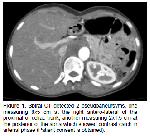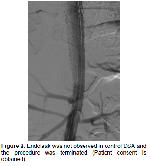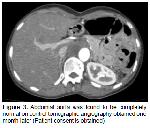Gunshot wound and stabwound injuries are together with high mortality rates. This condition usually requires open surgery due to organ injuries and active hemorrhage. Endovascular repair of abdominal aorta injuries were rarely reported and these cases include the hemodynamically stable, pseudo aneursyms, traumatic arterio-venous fistulas and dissections
3.
Retroperitoneal position of abdomial aorta and the large amount of surrounding tissues may result in local hemorrhage's stoppping with local tamponate formation. Fibrozis of the surrounding tissues and absorption of the hematoma content may lead to chronic pseudoaneursym formation in some of the cases4. Abdominal and low back pain, pulsatile mass, compression on neighbouring tissues, gastrointestial hemorrhage and death due to sudden rupture can be seen5. Clinical symptoms may appear either a short time after the injury, weeks, months or years later6-8. Thorasic CT angiography is an effective screening modality in patients with penetrating injuries to the child9. In this case we detected two pseudoaneursyms originating from aorta at the celiac trunk level on CT angiography obtained due to detection of a mass lesion on MRI taken for investigating the etiology of paraplegia 28 days after the injury too.
Endovascular treatment may have many advantages in aortic trauma including effective and sufficient treatment of the regions which are difficult to reach, shorter operative time, using less heparin, less hemorrhage particularly in multipl trauma patients, less complications like paraplegia or visceral organ injury related with cross-clamping ischemia time10-11.
White et al.3 successfully closed the aortic pseudoaneursym developing between superior mesenteric artery and renal arteries due to a stabwound injury with endovascular method and they reported no complications on their follow up of 16 months. Singh et al.12 applied endovascular repair to the pseudoaneursym at the proximal of celiac trunk due to a stabwound injury and reported no complications on their follow up of one year. Tucker et al.13 applied pseudoaneursym repair using aortic cuff in a patient who developed a pseudoaneursym in supra-celiac aorta and fistulized to vena cava as the result of stabwound injury and reported no complications on follow up.
In our case, we applied endovascular repair to 2 pseudoaneursyms located in anterior and posterior sides of the aorta including celiac trunk in a 13-year old child. In the literature, it was reported that they did not apply coil embolization before the procedure due to 98% stenosis at celiac trunk. Coil embolization was not performed due to 80% stenosis in celiac trunk due to the compression of pseudoaneursym also in our case.
The reason for preferring endovascular repair was the patient's and the family's refusal of an open surgery again and pseudomonas growing in wound culture. Goretex 21 mm TAG was considered to be proper as the diameter of proximal aorta was 16 mm. The shortest length, 100 mm was chosen. A long graft was used as it was considered not to change the clinical condition of the patient who was already paraplegic and had urinary incontinence.
Long term results of endovascular surgery are not known in penetrating aorta injuries. Penetrating injuries usually occur in the young. Therefore durability of endografts is very important and further studies are required. In conclusion, endovascular repair should be preferred in only the patients in whom open surgery is risky and these patients should be monitored closely, as reported in literature.





